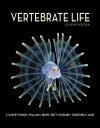Textbook
By: F Harvey Pough(Author), William E Bemis(Author), Betty Anne McGuire(Author), Christine M Janis(Author)
636 pages, 744 colour & b/w photos and colour illustrations
![Vertebrate Life Vertebrate Life]()
Click to have a closer look
About this book
Contents
Customer reviews
Biography
Related titles
About this book
Vertebrate Life distils the necessary information from vertebrate anatomy, physiology, ecology, and behavioural studies and then helps students see important connections across levels of biological scale. The result is students come to understand how organisms function effectively in their environments and how lineages of organisms change through evolutionary time. Processing complex detailed information about expansive phylogenies and diverse anatomies can be difficult for even the most motivated students, and Vertebrate Life addresses this challenge by combining appropriately-detailed, clearly-written text with outstanding phylogenies and figures, making it a thorough and engaging reference for students and instructors alike. The text's impressive illustration program helps students visualize complex concepts, allowing them to parse difficult anatomical information. The 11th edition has an upgraded illustration program with several new and revised figures.
Contents
Preface
Chapter 1. Diversity, Classification, and Evolution of Vertebrates
Chapter 2. What Is a Vertebrate??
Chapter 3. Jawless Vertebrates and the Origin of Gnathostomes
Chapter 4. Living in Water
Chapter 5. Geography and Ecology of the Paleozoic
Chapter 6. Origin and Radiation of Chondrichthyans
Chapter 7. Origin of Osteichthyes and Radiation of Actinopterygian
Chapter 8. Sarcopterygians and the Origin of Tetrapods
Chapter 9. Origins of Lissamphibia and Amniota
Chapter 10. Geography and Ecology of the Mesozoic
Chapter 11. Living on Land
Chapter 12. Lissamphibians
Chapter 13. Synapsids and Sauropsids: Two Ways of Living on the Land
Chapter 14. Ectothermy and Endothermy: Two Ways of Regulating Body Temperature
Chapter 15. Lepidosaurs
Chapter 16. Turtles
Chapter 17. Crocodylians
Chapter 18. Avemetatarsalia and the Origin of Dinosauria
Chapter 19. Theropods and the Origin of Birds
Chapter 20. Geography and Ecology of the Cenozoic
Chapter 21. Extant Birds
Chapter 22. Synapsids and the Origin of Mammals
Chapter 23. Therians
Chapter 24. Primate Evolution and the Emergence of Humans
Appendix
Glossary
Index
Customer Reviews
Biography
F. Harvey Pough began his biological career at the age of fourteen when he and his sister studied the growth and movements of a population of eastern painted turtles in Rhode Island. His research now focuses on organismal biology, blending physiology, morphology, behavior, and ecology in an evolutionary perspective. He especially enjoys teaching undergraduates and has taught courses in vertebrate zoology, functional ecology, herpetology, environmental physiology, and the organismal biology of humans. He has published more than a hundred papers reporting the results of field and laboratory studies of lizards, frogs, sea snakes, and tuatara that have taken him to Australia, New Zealand, Fiji, Mexico, Costa Rica, Panama, and the Caribbean as well as most parts of the United States. Undergraduate students regularly participate in his research, and are coauthors of many of his publications.
Christine M. Janis is a Professor of Biology at Brown University where she teaches comparative anatomy and vertebrate evolution. A British citizen, she obtained her bachelor's degree at Cambridge University and then crossed the pond to get her Ph.D. at Harvard University. She is a vertebrate palaeontologist with a particular interest in mammalian evolution (especially hoofed mammals) and faunal responses to climatic change. She first became interested in vertebrate evolution after seeing the movie Fantasia at the impressionable age of seven. That critical year was also the year that she began riding lessons, and she has owned at least one horse since the age of 12. She is still an active rider, although no longer as aggressive a competitor (she used to do combined training events). She attributes her lifestyle to the fact that she has failed to outgrow either the dinosaur phase or the horse phase.
Textbook
By: F Harvey Pough(Author), William E Bemis(Author), Betty Anne McGuire(Author), Christine M Janis(Author)
636 pages, 744 colour & b/w photos and colour illustrations
"I really like the summary component of Pough et al. This will be extremely helpful for students to focus on the big picture points moving forward."
– Carly Anne York, Lenoir-Rhyne University
"I think Vertebrate Life has over many iterations of deeply scholarly editions has achieved an excellent treatment of the comparative evolution of adaptive form and function across the tree of vertebrate life. It excels at placing the comparative morphology and physiology of major vertebrate lineages into a clear phylogenetic context with outstanding integration of both extinct and extant forms through the history of space and time on Earth since the early Paleozoic. [In the upcoming edition,] I like the continued expansion to more mixed media illustrations. The increased use of multiple colors in displays and use of more photographs to complement drawn scientific illustrations continues to move in a productive direction for this chapter, and this new edition in general."
– Andrew M. Shedlock, University of Charleston
"Vertebrate Life really has been the top undergraduate textbook for a survey course on the evolution and form and function of vertebrate animals, for the better part of two decades. The new edition [has] upped the ante a bit in terms of clarity and coverage."
– Jonathan Weinbaum, Southern Connecticut State University
"[The new edition of Vertebrate Life] updates a previous edition of an excellent text with better organization and new information. [It has a] balance between presenting interesting information without overloading detail."
– Udo Savalli, Arizona State University
"Pough et al. has a wonderful variety of species that the students will find compelling. It is written in a very accessible writing style, [with a variety of] engaging species examples. The figures will greatly enhance student understanding with well-chosen and interesting examples."
– Claire Kendal-Wright, Chaminade University























![Kame no Kōra wa Abarabone: Jintai de Arawasu Ugokumonozukan [Turtle Shells Have Ribs: A Picture Book of Animal Anatomy Represented by the Human Body]](http://mediacdn.nhbs.com/jackets/jackets_resizer_medium/24/249897.jpg?height=150&width=99)













